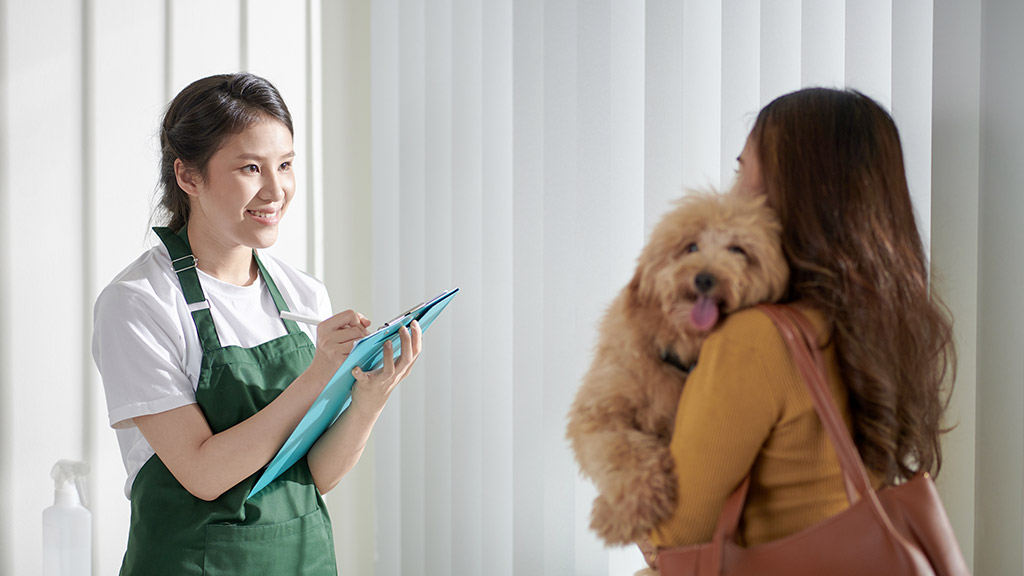There are no federal laws that govern animal welfare in Australia. However, every state and territory has legislation and regulations related to animal care, welfare or the prevention of cruelty to animals. The RSPCA Knowledge Base provides links to each of the relevant Acts.
Animal ethics are guidelines that govern the way people interact with and manage animals. You can think about ethical behaviour as ‘doing the right thing’ or ‘doing what is best’ for the animal. Although they are not laws, animal ethics protect and maintain animal welfare.
The World Organisation for Animal Health (WOAH) is an intergovernmental organisation that shares information about animal diseases and works with its international partners to improve the health and welfare of animals globally. The WOAH defines animal welfare as “the physical and mental state of an animal in relation to the conditions in which it lives and dies” (World Organisation for Animal Health n.d.).
As someone responsible for bathing, drying and brushing domestic dogs, you can be confident you are behaving ethically if you follow the principles of animal welfare, which are summarised as the Five Freedoms.
The Five Freedoms of Animal Welfare
The Australian Animal Welfare Strategy (AAWS) is a national plan that outlines improvements for animal welfare in Australia and ways to communicate Australian standards and expectations to domestic and international communities (Department of Agriculture, Fisheries and Forestry 2021). The AAWS was developed in collaboration with the Australian Government, state and territory governments, as well as relevant industry and community bodies.
The AAWS accepts the internationally recognised definition of animal welfare posed by the WOAH and the Five Freedoms that describe the conditions animals should experience when being managed by people.
The Five Freedoms are the:
- Freedom from hunger, malnutrition and thirst
- Freedom from fear and distress
- Freedom from heat stress or physical discomfort
- Freedom from pain, injury and disease
- Freedom to express normal patterns of behaviour.
The following table summarises the Five Freedoms’ basic principles that are relevant to bathing, drying and brushing domestic dogs and describes how to uphold them in the workplace.
| Freedom | The dog should have access to: | When working with the dog, you should: |
|---|---|---|
| Freedom from fear and distress |
|
|
| Freedom from heat stress or physical discomfort |
|
|
| Freedom to express normal patterns of behaviour |
|
|
However, some states and territories also have specific codes of practice or guidelines related to grooming. It is your responsibility to be aware of, understand and comply with the expectations of the state or territory in which you work. The following table provides hyperlinks to the various codes of practice and guidelines, current as of September 2023. Where a state or territory does not have guidelines specifically for dog grooming, refer and adhere to the overarching animal welfare legislation and regulations for that state or territory.
| State or Territory | Grooming Guidelines and Codes of Practice |
|---|---|
| New South Wales | NSW Animal Welfare Code of Practice - Animals in pet grooming establishments |
| Australian Capital Territory | Code of Practice for Pet Grooming Establishments - Australian Capital Territory |
| Victoria | RSPCA Victoria Grooming Guidelines: Welfare Grooming |
| Western Australia | Standards and Guidelines for the Health and Welfare of Dogs in WA |
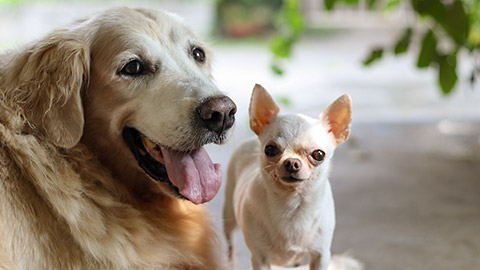
When washing, drying, and brushing a dog, it is very important to be able to recognize the breed and temperament of the individual dog. Understanding the breed and temperament means that you will be able to handle and work with the dog in a manner that is suitable for that animal.
A breed refers to a group of dogs that have been intentionally bred to have a specific appearance, size, and purpose. In Australia, Dogs Australia is the organisation responsible for registered purebred dogs. They currently identify and provide breed standards for 225 dog breeds (as of July 2023).
Basic Dog Anatomy
Before you can identify a breed, let alone confidently wash, dry and brush a dog, you must have a good understanding of basic dog anatomy.
- Muzzle: the section of the face that contains the nose and jaws of the dog
- Stop: slight indentation between the base of the muzzle and forehead (not always present)
- Ears: can be pricked – held upright, dropped – hanging down, or folded – sometimes called button ears
- Occiput: the highest point of the back of the skull
- Neck: from the base of the skull to the withers
- Withers: top point of the shoulder – the highest point on the dog’s back
- Loin: the section between the end of the rib cage and the start of the pelvic bone
- Flank: side of the body between the chest and base of the tail
- Croup or rump: where the pelvic bone is – from the start of the hips to the tail set
- Tail: a typically flexible extension of the backbone
- Tail set: the base of the tail – where the tail joins the body
- Throat: the soft section between the base of the jaws and the chest
- Chest: the section of the body containing the rib cage
- Hindlimbs: the two back legs of the dog
- Upper thigh: between the hips and the stifle
- Stifle: middle joint (knee) of the hindlimbs
- Lower thigh: between the stifle and the hock
- Hock: ankle joint of hindlimbs
- Paws: the foot at the end of each limb. Forefeet on front limbs and hind feet on hindlimbs
- Abdomen: belly
- Forelimbs: the two front legs of the dog
- Shoulder: top section of the forelimbs between the withers and elbow
- Elbow: first joint of the forelimbs
- Forearm: from elbow to wrist of forelimbs
- Wrist: lower joint of forelimbs (Bonham 2021).
Use the arrows to view all the examples in the following image slider.
- French Bulldogs are an example of a breed with pricked ears,
- Jack Russell Terriers have folded ears,
- All breeds of Spaniel have dropped ears.
Breed Standards and Temperament
Breed standards are a set of guidelines and criteria that describe the ideal characteristics, appearance, temperament and function of a particular dog breed. They serve as a blueprint for breeders, dog show judges and enthusiasts to maintain and evaluate the desired qualities of a breed. Breed standards also help identify a dog’s particular breed by specifying physical attributes like size, shape, coat type, colour and patterns, as well as behavioural traits and abilities that are considered desirable for that breed.
To identify a dog's breed using breed standards, you need to compare the characteristics described in the document with the dog in front of you. It is important to read the information carefully and understand the descriptions correctly. Finding the right breed within the document might take a few attempts if you are unfamiliar with different breeds. If you are unsure about the identification, seeking confirmation from someone with more experience is recommended.
Identifying a Dog breed
When identifying a dog’s breed, consider the following physical characteristics and compare the physical animal with the descriptions provided in the breed standard.
- How tall is the dog at the withers (the ridge between the shoulder blades)?
- What are the overall proportions of the dog, including the relative lengths of the front and back legs, the length of the back and the length of the neck?
- What length, colours, style (wavy or straight) and texture is the coat? Is it a double or single coat?
- What shape are the head and muzzle?
- What shape are the ears? Are they long or short? Are they pricked, folded or dropped? Where are they positioned on the head?
- What is the position of the tail set, how long is the tail, and how does the dog hold it (for example, low, straight or curled up across the back)?
Temperament
Breed standards often provide information about the breed’s typical temperament. Temperament refers to the overall behaviours and emotional states expected from a particular breed or an individual animal.
For instance, Dogs Australia (2015) describes the temperament of the Estrela Mountain Dog breed as a "faithful flock guardian, bravely protecting it against predators and thieves” and “distrustful towards strangers and typically docile to its master". On the other hand, the Welsh Terrier breed is typically known for being “happy and volatile rarely of shy nature. Game and fearless but definitely not aggressive although at all times able to hold his own when necessary” (Dogs Australia 2009).
An animal's general temperament is one factor used to categorise dog breeds into specific groups. Nonetheless, it is crucial to remember that breed standards are only generalisations. It is always necessary to consider the individual animal in front of you rather than assuming it perfectly matches the expectations outlined in the breed standard.
Activity: Interpret Breed Standards Documents - Dogs
Go to the Dogs Australia website and locate the Breed Standards for the Xoloitzcuintle. Then, answer the following questions.
- Which breed Group includes the Xoloitzcuintle?
- Which coat types do the Xoloitzcuintle have?
- How are the ears of a Xoloitzcuintle described?
- What is the typical temperament of a Xoloitzcuintle?
Q1 Answer: The Xoloitzcuintle is included in the Non Sporting Group.
Q2 Answer: Xoloitzcuintle dogs are either hairless or coated, which is “tight, flat and smooth with no undercoat” (Dogs Australia 2014).
Q3 Answer: Xoloitzcuintle ears should be long, large, expressive, and erect.
Q4 Answer: Xoloitzcuintle dogs are calm, quiet, cheerful, intelligent and alert. They make great watchdogs and companion dogs, and are never aggressive.

Coat Types
Different dog breeds have different coat types and, as a result, have different washing, brushing and grooming needs. Dog coat types can be broadly grouped into seven categories:
- Hairless
- Long or drop coats
- Double or heavy coats
- Combination or silky coats
- Fluffy, curly or wavy coats
- Short or smooth coats
- Wiry coats
Hairless
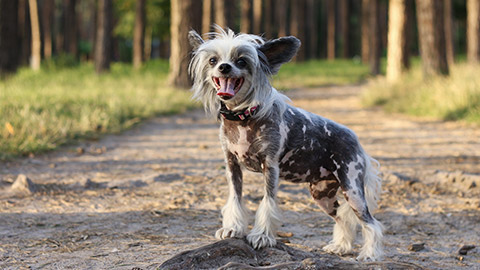 Example hairless breed: Hairless Chinese Crested |
General description | Hairless dogs have little to no hair. Some individuals have an all-over covering in short, downy hair. |
|---|---|---|
| Common breeds | Xoloitzcuintle, American Hairless Terrier, Peruvian Hairless Dog and Chinese Crested – Hairless | |
| Bathing considerations | Hairless breeds are more prone to sunburn and skin issues than breeds with hair. They require regular bathing with a gentle shampoo and a soft sponge. Make sure to give them a good rinse with clean water afterwards. Towel off and then use a very light blow dry or allow to air dry. Apply a light moisturiser or sunscreen when necessary, any excess moisturiser or sunscreen may block pores and lead to acne or other skin conditions. | |
| Brushing considerations | Most breeds do not require any brushing. However, the Hairless Chinese Crested has long tufts of hair on its head, feet and tail, which require frequent brushing (Petway Petcare n.d.). |
Long or Drop coats
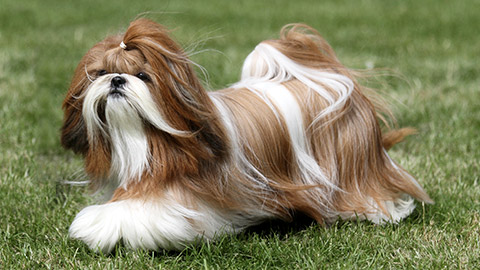 Example long-coated breed: Shih Tzu |
General description | Drop coats have long, silky hair that is continuously growing. Drop-coated breeds tend to shed seasonally, rather than year-round. |
|---|---|---|
| Common breeds | Maltese, Shih Tzu, Tibetan Terrier, Bearded Collie, Lhasa Apso, Silky Terrier, Yorkshire Terrier, Havanese, Briard and Chinese Crested – Powderpuff | |
| Bathing considerations | Check for large matts and brush them out before bathing. Detangling shampoos may help to prevent tangling during bathing. Conditioners may help prevent future tangles. When drying, use a flatten nozzle and hold the dryer far enough away that it doesn’t ‘whip’ the coat and create knots or matting. | |
| Brushing considerations | Daily brushing or combing is needed to prevent tangles and matting. Use a pin brush or slicker brush to remove any tangles, then finish with a soft bristle brush (Petbarn 2020). |
Double or Heavy coats
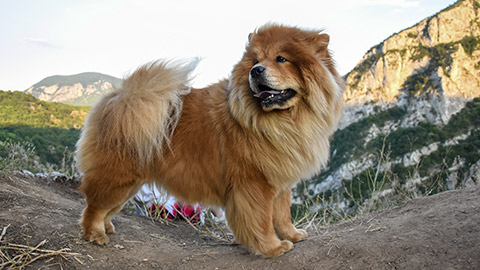 Example double-coated breed: Chow Chow |
General description | Double-coated dogs have two layers of hair. The undercoat is typically soft and thick and provides excellent insulation. The outer coat, often called guard hairs, tends to be coarse and prevents water and dirt from penetrating to the skin. Double-coated dogs can have short, medium or long hair. |
|---|---|---|
| Common breeds | Malamute, Pomeranian, Japanese Spitz, Collie – Rough, Sheltie, Chow Chow, Siberian Husky, Samoyed, Bernese Mountain Dog and German Shepherd - long stock coat | |
| Bathing considerations | Ensure the coat is thoroughly wet down to the skin before working the product completely through the hair. A de-shedding shampoo can help remove dead and loose hair from the undercoat. Use a blow dryer to ensure the undercoat is fully dried. | |
| Brushing considerations |
Frequent (multiple times per week) brushing is needed to prevent tangles. For short-haired double-coat breeds, use a pin brush or slicker brush to brush the undercoat, starting from the skin and working towards the tips of the hair. Use an undercoat rake and a wide-toothed comb to brush out the undercoat in sections for long-haired double-coat breeds. Use a detangler, if necessary, to remove knots. Then, for both short- and long-haired breeds, brush out the outer coat in the direction of the hair (Petbarn 2020). Some breeds, such as German Shepherds and Border Collies, have thicker hair around the hind limbs. So, it is important to spend a little extra time brushing these areas. |
Combination or Silky coats
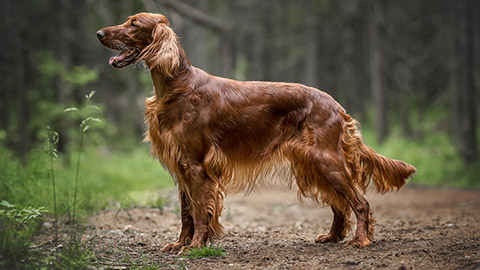 Example combination-coated breed: Irish Setter |
General description | A combination coat is one that tends to be short around the face, back, sides and front of the legs, but long and silky on the back of the legs, abdomen, tail and sometimes the ears. |
|---|---|---|
| Common breeds | English Cocker Spaniel, English Springer Spaniel, Golder Retriever, Border Collie, Tibetan Spaniel, Cavalier King Charles Spaniel, Dachshund – Long Haired, Aussie Shepherd, Chihuahua – Long Haired, and Irish (Red) Setter | |
| Bathing considerations | Detangling shampoos may help to prevent tangling during bathing. Conditioners may help keep the hair strong and glossy. Dry them with a blow dryer. | |
| Brushing considerations | Daily brushing or combing is needed to prevent tangles and matting. Use a slicker or pin brush to remove any tangles, then finish with a soft bristle brush (Petbarn 2020). |
Fluffy or Curly or Wavy coats
 Example curly-coated breed: Lagotto Romagnolo |
General description | In these breeds, the hair forms tight spirals, soft curls or waves and sits close to the skin. Wavy coats tend to shed less than other breeds, but the shed hair often gets trapped in the coat. |
|---|---|---|
| Common breeds | Bichon Frise, Poodle, Kerry Blue Terrier, Portuguese Water Dog, Bedlington, Lagotto Romagnolo and Irish Water Spaniel | |
| Bathing considerations | Check for and brush out any significant matts before wetting the coat. Use a moisturising shampoo to prevent tangles and to help reset curls in breeds such as the Lagotto Romagnolo. Volumising shampoos help the coat to stand up and stay fluffy in breeds such as the Bichon Frise and Bedlington Terrier. Make sure to fully rinse out all the products before towelling and blow drying. | |
| Brushing considerations | Use a curved or straight slicker to gently brush with the direction of hair growth to remove tangles, then against the hair growth direction to fluff the coat. Starting at the skin and brushing upwards removes the loose hairs and prevents tangles. Brush while blow drying (Petbarn 2020). |
Short or Smooth coats
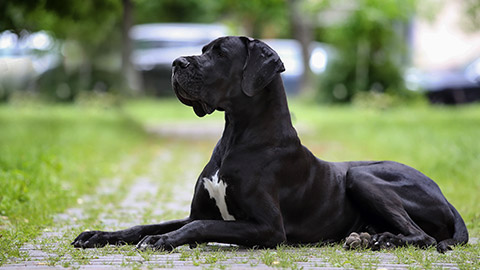 Example smooth-coated breed: Great Dane |
General description | Smooth coats are formed by short, silky hairs lying flat against the skin. The hair tends to shed all year round. |
|---|---|---|
| Common breeds | Boxer, Dalmatian, Staffordshire Bull Terrier, French Bulldog, Chihuahua – Smooth Coat, Great Dane, Dachshund – Smooth, Fox Terrier – Smooth, Pug, Beagle, Labrador, Rottweiler and German Shepherd - stock coat | |
| Bathing considerations | Normal shampoos will remove dirt and natural skin oils that cause the ‘doggy odour’. Using a bathing or exfoliating mitt to work the shampoo through the coat can help remove loose hair and skin cells. Deshedding shampoo will also help to remove excess hair. Use a towel to remove excess water, then give a gentle blow dry or allow to air dry. | |
| Brushing considerations | This coat type only needs a quick brush every few days with a soft to medium bristle brush to remove excess dirt and loose hair, and to distribute the natural oils evenly across the coat (Petbarn 2020). |
Wiry coats
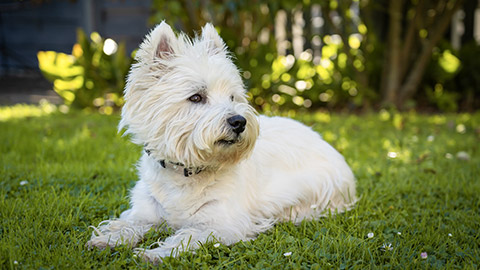 Example wiry-coated breed: West Highland Terrier |
General description | Wiry coats have coarse guard hairs and typically have a softer undercoat. Wiry hair does not naturally shed. It must be removed during brushing. |
|---|---|---|
| Common breeds | Airedale Terrier, Fox Terrier - wire, Schnauzer, Border Terrier, Scottish Terrier, West White Highland Terrier, Lakeland Terrier, Welsh Terrier, Cairn Terrier, Irish Terrier and Jack Russell - wire | |
| Bathing considerations | Normal shampoos and conditioners to remove dirt. Conditioners are particularly important for a softer coat because wiry coats also tend to be quite coarse. | |
| Brushing considerations | Brushing and stripping are needed to remove the dead hair from the coat. Brushing removes the dead hair from the undercoat while hand stripping removes it from the topcoat. Brush out long furnishings (the longer accent hairstyles on wire coats, such as the moustache, eyebrows and skirt) to remove and prevent tangles. A de-matting rake may be necessary for tougher matts. |
Safety Requirements of Bathing, Drying and Brushing Dogs
Work Health and Safety for Groomer
As with all job roles, several hazards are associated with bathing, drying and brushing dogs. The following table, adapted from Dog Groomers Association of Western Australia (2014), summarises nine common safety hazards in a grooming workplace, the harm they may cause and ways to minimise the risk.
| Hazard | Examples | Potential harm | How to minimise the risk |
|---|---|---|---|
| Manual lifting | Lifting animals on and off tables or into and out of baths | Muscular strain |
|
| Slips, trips, falls and gravity | Slipping on wet floors, tripping over electrical cables, dropping items onto feet | Bruises, lacerations, dislocations, fractures, concussion, permanent injuries or even death |
|
| Electricity | Exposed wire in a faulty cord comes into contact with water | Electrical shock, electrical burns, electrocution or causing a fire |
|
| Equipment | Getting fingers caught in a lifting table or being cut by sharp tools | Bruises, lacerations, dislocations, fractures, concussion, permanent injuries or even death |
|
| Hazardous chemicals | Skin irritation from cleaning products | Skin irritation, dermatitis, respiratory diseases or cancer |
|
| Extreme temperature | Exposure to heat from dryers or hot water | Heat stress, burns or scalds |
|
| Noise | Long-term exposure to noisy equipment, such as dryers, and dogs barking | Permanent hearing damage |
|
| Zoonosis (the spread of disease from animals to humans) | Contracting ringworm from an infected dog | Illness from an infectious disease contracted from dogs, such as Leptospirosis, ringworm, rabies, Salmonella or parasites, such as fleas or worms. |
|
| Animal handling | Bites and scratches from handling dogs | Bruises, lacerations or infected wounds. |
|
| Psychological | Stress arising from working with neglected or vulnerable animals, or inappropriate clients | Work-related stress and anxiety, emotional trauma and other mental health issues |
|
Other common hazards in the pet grooming industry include:
- allergies and respiratory issues caused by the inhalation of hair, dander and nail grindings
- eye injuries from impact with loose hair, dander and nail debris
- exposure to natural from faulty gas hot water services
- poisoning or other illnesses caused by poor workplace or personal hygiene, such as from a build-up of toxic mould.
The previous examples are only a few potential hazards associated with bathing, drying and brushing dogs. If you have any safety concerns, discuss them with your supervisor or another appropriate person at your workplace.
Safety Requirements for the Dogs
When upholding animal welfare and ethics, you must consider the safety of the dogs you are working with. The following are a few critical things to remember when bathing, drying and brushing dogs.
- Never leave a dog unattended in a bath or on a grooming table, even if the dog is tethered. Dogs may fall and hang themself on their restraint very quickly. Frequently check on dogs in their enclosures to ensure they are at a comfortable temperature, particularly when using cage dryers.
- Always check the water pressure and temperature before bathing to prevent scalds (burns with hot water) or injury from high-pressure water in sensitive areas. Check the temperature of dryers (use low heat setting where possible) to prevent burns or heat stress.
- Always check that the dog is completely dry down to the skin. Poor drying practices may result in damp spots that cause canine hot spots, a form of skin inflammation that forms red patches of skin that are hot to the touch and may ooze pus.
- Avoid brush burn and razor burn, patches of tiny abrasions to the skin caused by repetitively brushing the same area with a hard brush or by shaving too close to the skin. Only use light pressure, especially when using new brushes, which may be sharp.
- Haematomas are large blood blisters that form when blood quickly rushes back into a patch of skin, such as after being restricted for an extended period by matted hair or by excessive and vigorous head shaking after the dog gets water in their ears or have the insides of their ears shaved. They commonly form in and around the ears. If you notice a haematoma, report it to the owner so they can have a veterinarian check and treat it (Canine to Five 2020).
- Thoroughly rinse the dog during bathing, to remove all products and prevent chemical irritation or burns to the skin and eyes.
- Change your gloves every time you start working with a new dog to prevent the possible spread of infectious diseases between animals. Proper workplace hygiene is another effective form of infection control.
- Poor or rough handling of the dog may cause physical injuries to ligaments, joints or muscles. Dogs may also sustain cuts and bruises from interactions with other dogs or from falling equipment. Dog eyes are particularly sensitive and prone to injury.
- Dehydration is also common and can occur very quickly with small dogs, puppies and some double-coated breeds such as the Malamute. Make sure to give the dog plenty of breaks and fresh water throughout long grooming sessions.

Receive Work Instructions and Client Requests
Work instructions provide the specific information required for the bathing task. Depending on your workplace, the work instructions may be provided as a computer file, a paper form or a whiteboard table of the day’s appointments, or even as a text message or a sample photograph.
The specific information included in the work instructions will depend on your workplace. However, common details may include the following.
- The dog’s name and breed
- The specific product/s required for that dog
- The type of service the dog requires in terms of bathing, clipping and styling
- Special handling requirements for the dog
- Health issues of which the groomer should be aware
- Dietary requirements
- Expected pick-up time
- Other services required, such as dog minding.
The client (the person requesting the dog be bathed and brushed) may have specific requests that will also be included in your work instructions. Client requests may include, but are not limited to:
- using a specific product, such as a medicated or sensitive shampoo
- removing matted fur
- the equipment to use when drying the dog
- styling the coat in a particular way
- cleaning the ears and eyes.
You may receive your work instructions orally – having your supervisor or client tell you what is required – or they may be written, such as in the individual animal record or client booking information. View the ABG Boarding Grooming Booking Form (pdf) as an example of typical work instructions.
Interpret Workplace Documents
An individual animal record and client booking forms are examples of workplace documents that contain information to help you determine exactly what tasks are required of you.
Other workplace documents will provide you with information about how to use and store equipment and products safely. You must correctly interpret these documents for your safety and that of the animals and other people you work with.
Equipment manuals
Many items for grooming equipment, such as clippers, powered bathing units and lifting tables, will have a manual. An equipment manual provides information about how to:
- set up the equipment correctly
- change the settings and the purposes of the different settings (if the item has them)
- use the equipment safely according to the manufacturer’s recommended limits, such as maximum weight or volume capacity
- clean and maintain the equipment in good working order
- store the equipment properly to maximise its working life.
You are responsible for locating, interpreting and following the instructions in equipment manuals. Not following the manufacturer’s guidelines may be unsafe for you, your colleagues or the animals you work with. Improper use may also void the warranty on the equipment, preventing the organisation from having damaged or faulty equipment repaired or replaced for free.
If you are not confident with your interpretation of an equipment manual, make sure you confirm your understanding with someone more experienced before using the equipment.
Safety data sheets
Most chemicals used in the animal care industry, such as disinfectants and many grooming products, will have a corresponding safety data sheet (SDS). SDSs provide “safety information about hazardous chemicals that can help keep workers safe” (Safe Work Australia n.d.).
Key information contained in SDSs includes:
- active or harmful ingredients in the chemical
- potential hazards of the chemical
- ways to handle the chemical safely
- ways to store the chemical safely
- first aid information and what to do in an emergency involving the chemical (Safe Work Australia 2012).
Your workplace must store relevant SDSs so all employees can access them anytime. Make sure you know where the SDSs are stored at your workplace and how to access them. The Understanding Safety Data Sheets for Hazardous Chemicals (pdf) factsheet explains the type of information contained in each section of an SDS as well as general information regarding the purpose of SDSs. Review the factsheet to refresh your memory of how to interpret these important workplace documents.
Discuss the needs of the individual dog
Once you are comfortable with all the equipment and products you will use, it is important to understand the needs of the individual dog that you will be working with. The client will typically be the best person to get this information from. You can discuss the dog’s specific requirements with the client when they make the booking or when they drop the dog off.
Record all the information so that all employees can understand the dog’s needs. You may not be the person to work with that dog at the time, and the information may be useful for return visits.
Common factors to consider and questions to ask when determining the individual needs of the dog include:
- Overall health – Is the dog in good health? If not, then it may be best to postpone the bathing appointment until the dog is well again.
- Injuries – Is the dog recovering from any injuries? Again, it may be best to postpone bathing until the dog is fit and well.
- Skin conditions – Does the dog have any skin issues that may be aggravated or treated by using particular products? Will the skin condition cause the dog discomfort during bathing, drying or brushing?
- Age-related issues – Older dogs may suffer from arthritis or sight or hearing loss. Young puppies may be unfamiliar with the bathing process or handling in general. Does the dog have any special handling requirements?
- Individual temperament – Does the dog have a history of anxiety or aggression that may be a safety issue for either the dog or the bather? What are the dog’s triggers? What handling techniques usually help the animal stay calm?
- Dietary requirements – Can you give the dog treats to help encourage them during the bathing and brushing processes? If so, are there particular treats that are appropriate or should be avoided?
Understanding the dog’s needs will reduce safety risks for both you and the dog, and help build a positive association for the dog with the bathing, drying and brushing experience.
Clarify and Confirm information
Always clarify and confirm your understanding of the relevant information by asking questions. You clarify by asking questions to obtain additional information or to have the information repeated in a different way. Clarifying questions help to give you a clearer understanding of the situation or the instructions.
For example, a client may ask for you to keep the coat long. However, “long” is open to interpretation. Where the client wants their dog to look a certain way, it can be very helpful to clarify using an image of the final product you are trying to achieve.
To confirm your understanding, you also ask questions. Confirming questions are a great way to check that you have understood correctly. Simple questions, such as “Is that right?” or “Have I understood you correctly?”, will usually suffice. Confirming understanding is important because it allows the other person to correct any miscommunication or errors before you take action.
Questioning skills
There are two main types of questions, open-ended and close-ended questions. Both types are necessary to clarify and confirm.
Open-ended questions require answers of more than just a few words in response. For example, “Can you please describe how best to keep your dog calm when he is feeling a bit anxious?”. Open-ended questions are great for gathering additional information and clarifying instructions.
Close-ended questions only require brief responses. For example, “Which is your preferred product?” or “Would you like us to call you when your dog is ready for pick-up?”. Close-ended questions are best for confirming your understanding.
Complete the following seven (7) activities to check your knowledge and understanding of the key concepts of this topic. You may repeat this activity as often as you like. Use the arrows to move between the different activities.
Refer to the following excerpt from a set of work instructions to answer Question 1.
